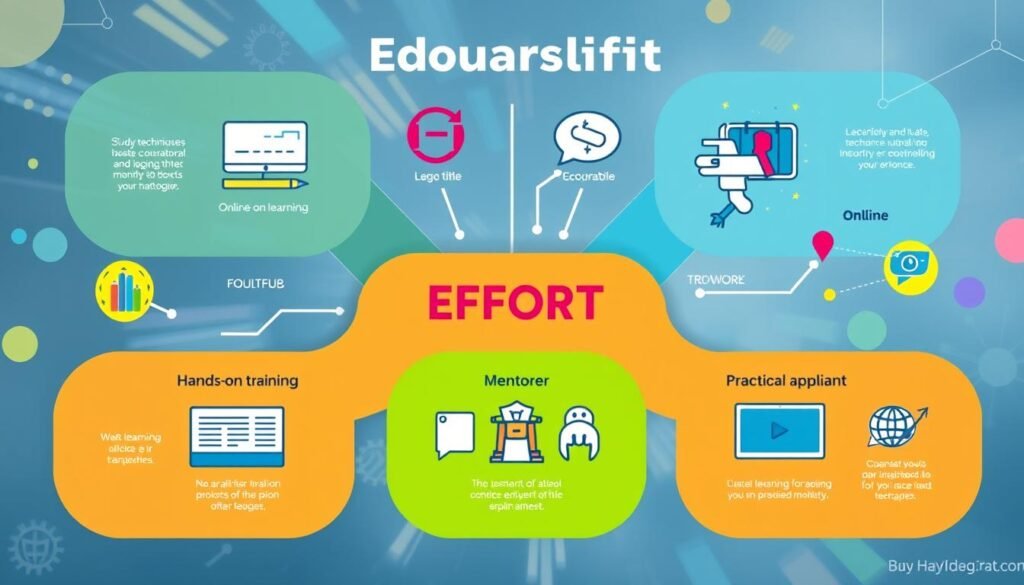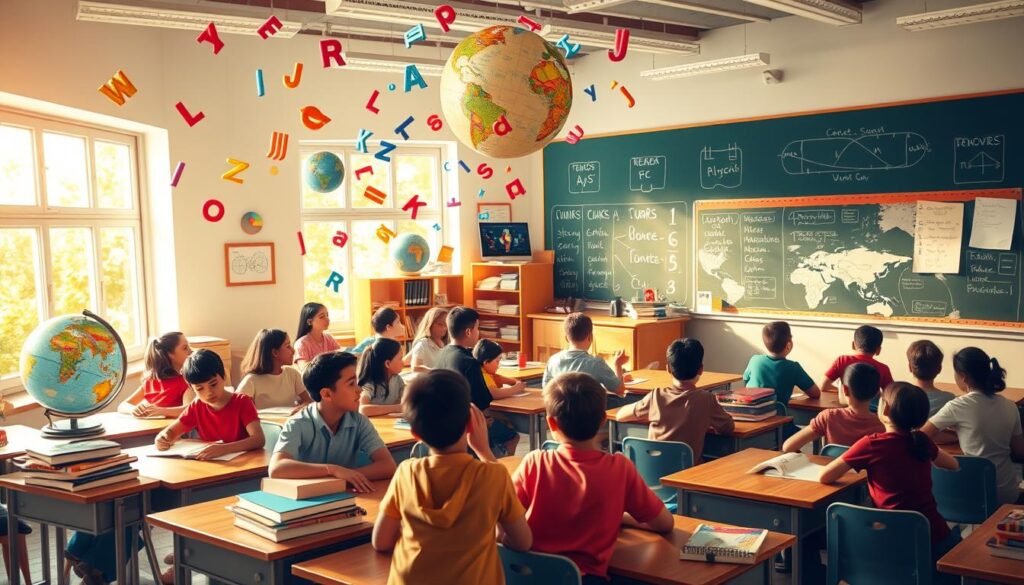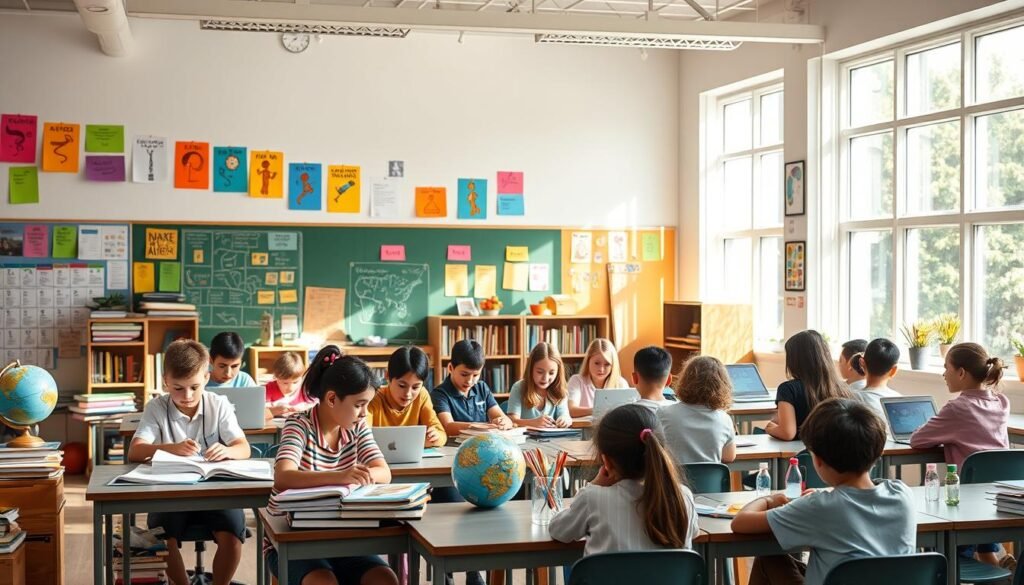In today’s fast world, turning educational effort into real results is key for students, teachers, and leaders. The secret to success is using a mix of research, tech, and knowing what motivates students. This way, we help learners reach their best and create a brighter future in education.
Key Takeaways : Educational Effort
- Leveraging active learning strategies, such as creating study guides and explaining concepts aloud, can lead to better learning outcomes.
- Organizing study materials by topic and practicing distributed learning can enhance information retention and deeper understanding.
- Eliminating distractions and maintaining a conducive study environment are crucial for improving concentration and productivity.
- Fostering strong teacher-student relationships and catering to individual learning preferences can boost student motivation and engagement.
- Incorporating technology-based solutions and incorporating multimedia resources can make educational content more accessible and engaging.
Defining Educational Effort
Educational effort is key to success and growth. It involves planned activities by educators to teach and help students grow. This effort goes beyond just classrooms, covering many programs and places.
Planned and Organized Activities
At the heart of educational effort are activities designed to engage students. These can happen in schools or outside, like field trips. Good effort means careful planning to ensure quality learning.
Educational Programs and Locations
Educational effort includes many programs and places. This includes school programs, vocational training, and more. Learning happens in many settings, from classrooms to online platforms.
Understanding educational effort helps improve education for everyone. It empowers individuals to achieve their best.
Essential Categories of Educational Effort

Research shows several key areas of educational effort from faculty’s view. These include the visibility of planned educational activities on the work schedule. They also match with how organizations see education. This shows that we can create standard ways to measure educational effort. The work schedule is a good place to start.
Visibility of Planned Educational Activities
It’s important to make educational activities clear on the work schedule. This helps measure and see faculty’s work in education. It lets organizations understand how much time and resources go into education. This helps in planning and supporting better.
Concordance with Organizational Perspectives
Another key point is how educational effort categories match with what organizations value. When faculty and organizations share the same view on education, it’s easier to measure educational effort. This shared understanding helps in using resources well for education.
| Category | Visibility on Work Schedule | Alignment with Organizational Perspectives |
|---|---|---|
| Didactic Instruction | High | High |
| Curriculum Development | Medium | Medium |
| Mentoring and Advising | Low | Medium |
| Scholarship and Research | Low | High |
The table shows how different educational efforts are seen and valued. It points out the need for a full approach to measure and value faculty’s work.
China’s Literacy and Educational Effort

China has seen a big leap in literacy rates. These rates have dropped from 85-90% at the start of the 20th century to almost all youth being literate by 2015. This effort is seen as one of the greatest in history.
Several factors have helped China succeed in literacy. These include more community and NGO help, better learning materials, using technology, and helping rural students escape poverty through education.
Yet, big gaps still exist. Urban people in China make much more money than those in rural areas. This difference shows up in school results too.
Primary schools in China have gone down from 668,685 in 1995 to 201,377 in 2014. This is because many students moved from rural areas to cities. This has made student-teacher ratios better in cities but worse in rural areas.
| Region | Literacy Rate | Education Index (EI) | Student-Teacher Ratio |
|---|---|---|---|
| Beijing | Near-universal | 0.854 | 15:1 (primary), 14:1 (secondary) |
| Shanghai | Near-universal | N/A | 15:1 (primary), 14:1 (secondary) |
| Tibet | 60.07% | 0.45 | N/A |
| Guangxi | N/A | N/A | 20:1 (primary), 24:1 (secondary) |
These differences show the big challenges China faces in education. It’s key to make sure all students get a fair chance to learn. China’s ongoing investment in education is crucial for achieving universal literacy and education.
The Role of Language in Educational Effort

In China, Mandarin Chinese is now the main language for education and government. But, places like Hong Kong resist because they value Cantonese as part of their cultural identity. The Chinese government’s push to limit minority languages like Cantonese is seen as a threat to these unique cultural identities.
This shows how complex and important language is in education and building a nation. While a common language helps with communication, banning local languages can hurt regional freedom and diversity.
Cantonese and Linguistic Nationalism
In Hong Kong, Cantonese is a key part of their identity, different from mainland China’s Mandarin Chinese. The Chinese government’s effort to make Mandarin more common has sparked local resistance. People see it as a way to lose their linguistic and cultural heritage.
The crackdown on Cantonese and other minority languages in China is seen as linguistic nationalism. It’s about making the country’s language more uniform for unity and identity.
Preserving Cultural Identities
Keeping cultural identities alive is key in education, especially in places like China. By supporting minority languages in schools, governments can help communities feel valued. This lets them keep their cultural traditions and ways of life.
The use of language in education is a fine line. It’s about finding a balance between a common language for unity and keeping the diversity that makes a country’s culture rich.
Also Read : Empower Your Future With A Degree In Education
Conclusion
This article has given a detailed plan for making education work better. It shows how to improve learning and outcomes. It also talks about the value of keeping cultural and language diversity alive.
The world of education is changing fast, with issues like COVID-19 and the need for more skilled workers. The ideas in this article help schools and leaders deal with these problems. They show how to balance making education better and keeping cultural heritage alive.
To sum up, the strategies here are a guide for teachers, leaders, and policymakers. They help turn education into real change. By focusing on goals, community, and diversity, we can make education better for everyone. This will help learners everywhere have a brighter future.
FAQs
Q: What are the key factors to consider when aiming to turn educational effort into productive results?
A: Key factors include understanding the concept of mental effort, utilizing self-regulated learning strategies, and being aware of cognitive load perspective to optimize learning gains.
Q: How does the cognitive load perspective influence educational psychology?
A: The cognitive load perspective suggests that managing cognitive load can enhance learning by helping students allocate their mental effort more effectively, thus leading to improved retention and understanding.
Q: What role does metacognition play in productive educational efforts?
A: Metacognition involves self-awareness about one’s learning processes, which allows learners to reflect on their strategies and adjust their approaches, ultimately improving their educational outcomes.
Q: What are “desirable difficulties” and how do they relate to learning effort?
A: Desirable difficulties are challenges that enhance learning by requiring more cognitive effort, leading to better retention and understanding of material, as discussed in the educational psychology review by Bjork and others.
Q: How can educators help students distinguish between intrinsic and extraneous cognitive load?
A: Educators can guide students to recognize which tasks require intrinsic load, essential for learning, versus extraneous load, which can hinder understanding, thereby optimizing their allocation of mental effort.
Q: What is the importance of author information in educational articles?
A: Author information provides credibility and context for the research, allowing readers to assess the qualifications and perspectives of those contributing to the body of knowledge in educational psychology.
Q: Why is it important to access this article for understanding educational psychology?
A: Accessing articles on educational psychology allows readers to engage with current research, including concepts like mental effort and self-regulated learning, which are crucial for effective educational practices.
Q: How can students’ perceptions affect their learning effort?
A: Students’ perceptions of their abilities and the value of tasks can significantly impact their motivation and effort levels, influencing their overall learning outcomes and engagement in educational activities.
Q: What strategies can be employed to improve allocation of mental effort in learning?
A: Strategies include setting clear learning goals, utilizing metacognitive practices, and fostering an environment that encourages reflection and self-assessment to enhance the allocation of mental effort.
Q: How do rights and permissions relate to educational resources?
A: Rights and permissions are essential for ensuring that educational resources are used ethically and legally, allowing educators and learners to access necessary materials while respecting copyright and intellectual property.
Source Links
- https://learningcenter.unc.edu/tips-and-tools/studying-101-study-smarter-not-harder/
- https://www.daniel-wong.com/2023/02/13/how-to-study-productively/
- https://theeducationhub.org.nz/10-strategies-that-promote-motivation/
- https://rady.ucsd.edu/_files/faculty-research/sadoff/Gneezy_et_al_Test_Effort_AERI_2019.pdf


